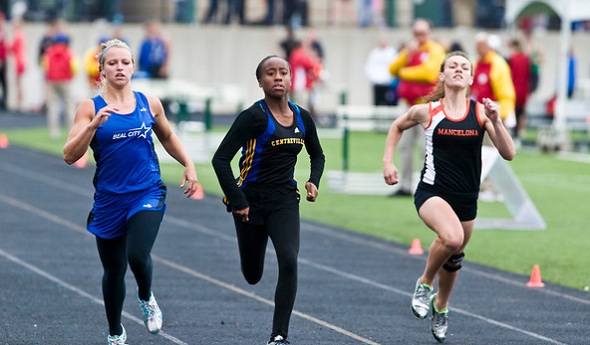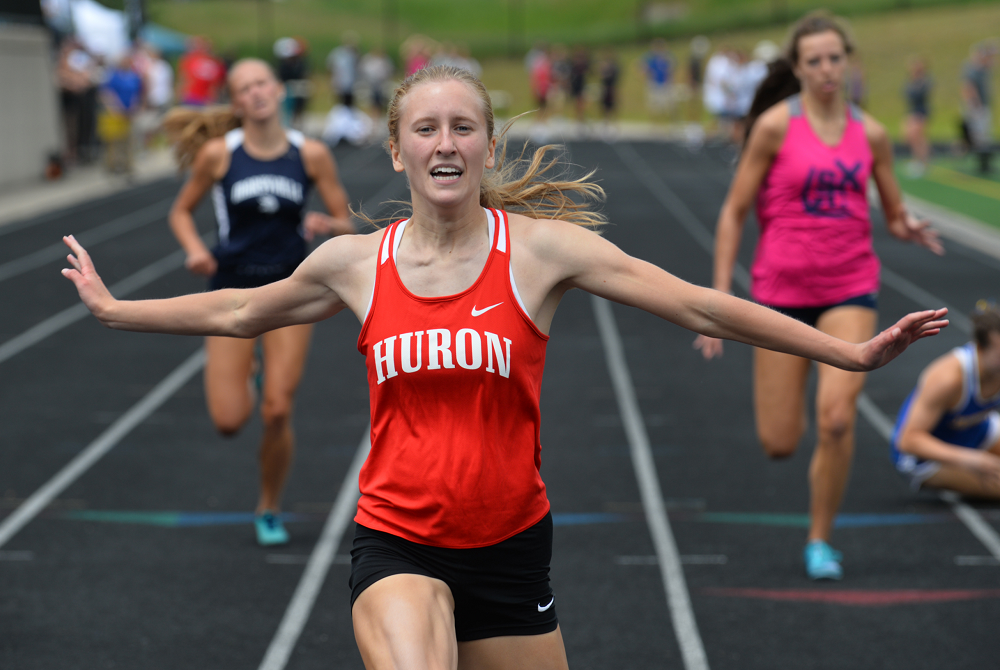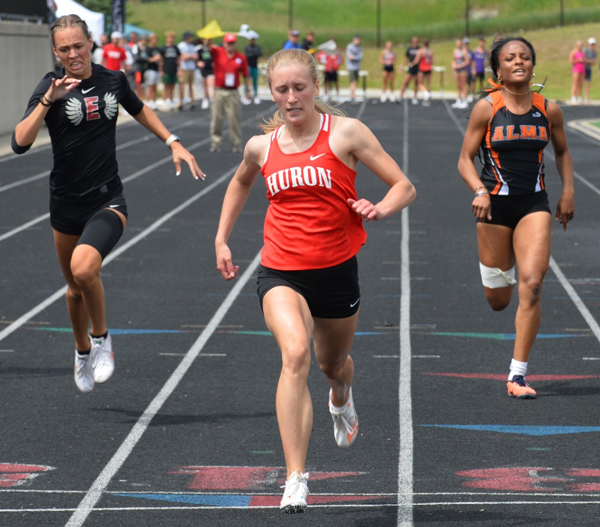
Girls Finals: Burning up the record book
June 2, 2012
By Geoff Kimmerly
Second Half editor
Rain or shine and everything in between couldn't keep a strong class of MHSAA Track and Field athletes from once again shining in the final girls meets of the season Saturday.
A total of 19 Finals records either were tied or broken during the seven championships events featuring schools from throughout both peninsulas. Three records were new bests for all Finals, regardless of division. And two athletes won four individual titles – another feat rarely seen.
Here's our breakdown of the best from Saturday's meets. It's impossible to include every highlight, of course. But feel free to comment below and tell us what we missed.
Headliner
Few have put together a Finals like Sami Michell’s in Division 3 – and no girl has done so in the Lower Peninsula since 1979. Adding to her three championships in 2011 and another in 2010, Michell won four events – long jump, 100 hurdles, 300 hurdles and the 200 – and set three records in the process, including the all-Finals mark in the 300 erasing what had stood since 1984. She’s only a junior, and nearly pulled off the four-title feat last season but finished second in the 200. The last girl to win four events at one LP Finals was Mason County Eastern’s Maria Shoup, who did so at the 1979 Class D meet with victories in the 100 hurdles, 200 hurdles, 800 and long jump.
Record setters
All Finals and LP D3/300 hurdles – Sami Michell, Reed City – 42.23
(All Finals previous was 42.4, set by Benton Harbor’s Carolyn Ferguson in Class A in 1984; previous D3 was 43.84, also by Michell, set in 2011)
All Finals and LP D1/3,200 relay – Kelsie Schwartz, Ersula Farrow, Haley and Hannah Meier – 8:48.29
(previous was 9:05.47, set by Rochester in 2010)
All Finals and LP D1/1,600 run – Erin Finn, West Bloomfield – 10:17.86
(previous was 10:22.75, set by Rochester’s Megan Goethals in 2010)
LP D1/High jump – Keianna Ingram, Southfield-Lathrup – 5-9
(ties previous set by Ann Arbor Pioneer’s Ariel Roberts in 2008)
LP D1/Long jump – Cierra Pryor, Jackson – 19-0
(previous was 18-9, set by Saginaw Arthur Hill’s Monsherri Hall in 2007)
LP D2/100 dash – Sydney Cureton, Detroit Country Day – 11.90
(previous was 11.92, also by Cureton, set in 2011)
LP D2/1,600 run – Sara Barron, Pontiac Notre Dame – 4:51.67
(previous was 4:54.07, set by Corunna’s Jamie Kryzmiski in 2000)
LP D2/400 dash – Kendall Baisden, Detroit Country Day – 54.58
(previous was 54.91, also by Baisden, set in 2010)
LP D2/3,200 run – Ali Wiersma, Allendale – 10:40.22
(previous was 10:40.66, set by Monroe Jefferson’s Beka Smeltzer in 2004)
LP D3/Long jump – Sami Michell, Reed City – 18-6.5
(previous was 18-1, set by Albion’s Juandretta Oliver in 2007)
LP D3/100 hurdles – Sami Michell, Reed City – 13.84
(previous was 14.07, also by Michell, set in 2011)
LP D3/800 run – Annie Fuller, Manistee – 2:13.03
(previous was 2:14.03, set by Albion’s Amelia Bannister in 2007)
UP D1/Long jump – Adeline Grier-Welch, Houghton – 17-3.5
(previous was 17-0.75, also by Grier-Welch, set in 2011)
UP D1/100 dash – Chelsea Jacques, Calumet – 12.55
(previous was 12.58, set by Escanaba’s Stephanie Ostrenga in 2005)
UP D2/Discus – Hunter Perry, Rudyard – 122-10.25
(previous was 120-4.75 by Iron River West Iron County’s Desirae Rasmussen in 2010)
UP D2/High jump – Nicole Vanderlin, Norway – 5-4
(ties previous record, also by Vanderlin, set in 2011)
UP D2/200 dash – Dani Gagne, Norway – 26.42
(previous was 26.47, set by Chassell’s Jamie Dompier in 2009)
UP D3/Long jump – Olivia Soumis, Ontonagon – 16-7.5
(previous was 16-5.5, also by Soumis, set in 2010)
UP D3/200 dash – Jamie Dompier, Chassell – 26.36
(previous was 26.65, set by Rapid River’s Stephanie Boyer in 2001)
Tales of the Trophy
LP D1: Grosse Pointe South continued its impressive two-year run with its second straight championship, this time by 13.5 points over Ann Arbor Huron. The same athletes who keyed the school’s cross country title in the fall did so again Saturday – distance runners Hannah and Haley Meier, Kelsie Schwartz and Ersula Farrow, plus sprinter Caitlin Moore.
LP D2: Detroit Country Day won six events and Dearborn Divine Child just two, but at the end of the afternoon they’d both scored 60 points to tie for the championship. Last season, Country Day was first and Divine Child second, while in 2009 those places were reversed. Country Day’s Brittany Mann repeated as champion in the shot put and discus, and Baisden won her third in the 400. Divine Child balanced the scoring with contributions from 10 entries.
LP D3: Frankenmuth won its third championship in four years and improved on last season’s runner-up finish by beating Benzie Central by 11. Relays were the key: the Eagles won both the 800 and 1,600 with Olivia Shelton, Emily Wee and Angela Ritter running on both, helped by Sydney Bronner on the 800 and Lauren Peterson on the 1,600.
LP D4: Fowler won its second straight after runner-up finishes in 2010 and 2009, edging Traverse City St. Francis by four points with a total of 54. Relays were the key for these Eagles as well. They won the 3,200 and 800 relays with seven athletes (Elizabeth Thelen was the only common runner between the two) to balance out wins by St. Francis’ Lauren Buckel in the 400 and 200.
UP D1: Marquette repeated and won its fourth in the last five seasons by edging Negaunee by seven points. Shayla Huebner and Jessica Fluette were half of the winning 1,600 relay and also won individual events. Fluette also was on the winning 3,200 relay.
UP D2: St. Ignace won its third straight and fourth in five seasons with 142 points – 46 more than runner-up Norway. The Saints won five events including a relay, with Sarah Cullip the star. She won the pole vault, 1,600 and 3,200.
UP D3: Brimley also repeated and won its fourth in five seasons, edging Eben Junction Superior Central by 12 points. Brimley won just four events, but got scoring from 12 entries.
So long, seniors
Cindy Ofili, Ann Arbor Huron – Won the 100, 200 and 100 hurdles and ran on the winning 800 relay at the LP Division 1 meet.
Kyra Jefferson, Detroit Cass Tech – Won the LP Division 1 200 championship for the third straight season, giving her four individual championships for her career.
Tori DeSira, DeWitt – Won the 100 hurdles and 300 hurdles at the LP Division 2 Final, giving her five individual championships for her career.
Sara Barron, Pontiac Notre Dame Prep – As well as setting a LP Division 2 record in the 1,600 (see above), Barron repeated as champion in the 800.
Dani Gagne, Norway – In addition to setting the UP Division 2 record in the 200, she also won the long jump, 100 and 400, giving her 10 championships total during her career.
Megan Kangas, Norway – Joined her teammate as a repeat champion, winning the 100 hurdles to finish her career with four MHSAA championships total.
Lauren Spanger – Eben Junction Superior Central – Won the UP Division 3 400 title for the third straight season and the 800 for the second time in three seasons.
Click for links to all results.
PHOTO: Competitors race to advance to the 100-meter championship race during Saturday's Division 4 Final. (Photo courtesy of RunMichigan.com. Click to see more.)

Multi-Sprint Champ Racing to Finish Huron Career Ahead of the Rest Again
By
Keith Dunlap
Special for MHSAA.com
May 25, 2023
NEW BOSTON – If there was one thing Elizabeth Anderson took pride in elementary school, it was simply showing that she could outrun everyone in sight.
 In fact, Anderson has an explanation for all the success she had in those playground races.
In fact, Anderson has an explanation for all the success she had in those playground races.
“Dominance when you are in elementary school,” Anderson quipped. “I don’t think I ever had a nickname. I just think everyone knew I was fast.”
Years later, pretty much everyone who follows track & field in the state of Michigan can attest to that.
A senior for New Boston Huron, Anderson has been faster than most other competitors in the state during her three-year high school career (with her freshman season in 2020 canceled due to COVID-19).
Last year, Anderson won titles at the Lower Peninsula Division 2 Finals in the 200-meter (25.07) and 400-meter (56.28) dashes, and was runner-up in the 100-meter dash (12.23).
Often, top sprinters focus on one or two of those three races. But Anderson is certainly a different breed of sprinter because she does all three.
In fact, she holds school records in all three of those events, and if all that weren’t enough, Anderson is a part of all three sprint relay teams.
“It is hard to give her events off,” said New Boston Huron head girls track coach Danielle Lobato.
Despite the different styles the 100, 200 and 400-meter dashes present, Anderson said there usually isn’t much adjusting when she goes from one of those races to another.
 The strategy is simply, “Let’s beat the other girls to the finish line.”
The strategy is simply, “Let’s beat the other girls to the finish line.”
“I don’t really go into each race changing up how I would run,” she said.
While enjoying and succeeding in all three races, Anderson said she actually does have a favorite among them.
“I would say the 400 is probably my favorite,” she said. “Even though it hurts, it’s satisfying to see how much you can get your time down in the 400 compared to any other race.”
Anderson said she started running track in sixth grade, but really got serious about it during the summer after her sophomore season, when she was invited to run for a local club.
Eventually, that led to her competing over the winter in indoor events.
She lived and breathed track so much that last fall, she decided to not run cross country so she could focus on a weightlifting regimen aimed at developing more leg strength.
“Once I started doing summer track, I realized I wanted to be doing this all the time,” she said.
Lobato said oftentimes in practice, Anderson is a de facto coach, given there is no better person she can think of for the younger runners on the team to learn from.
“I can’t always demonstrate these things I’m trying to teach,” she said. “You get to see it in real life (from Anderson), not in a YouTube video.”
After winning the 100, 200 and 400-meter dashes at her Regional meet last week, Anderson has her sights set on achieving the same trifecta of titles at next Saturday’s Finals in Grand Rapids.
Anderson has signed to run track at Michigan State, but has been plenty motivated to keep producing this spring in her final high school season.
“I’m really looking to defend my titles,” she said. “That is what is really motivating me to keep going. I want to keep in shape for the college season. I don’t want to lose any of the progress I have made. Ultimately, I just love running track.”
And since elementary school, Anderson has loved — and succeeded in — outrunning everyone else to the finish line.
“We knew we were getting something special,” Lobato said of when Anderson arrived in high school. “But you never expect this. All that she has accomplished is amazing.”
 Keith Dunlap has served in Detroit-area sports media for more than two decades, including as a sportswriter at the Oakland Press from 2001-16 primarily covering high school sports but also college and professional teams. His bylines also have appeared in USA Today, the Washington Post, the Detroit Free Press, the Houston Chronicle and the Boston Globe. He served as the administrator for the Oakland Activities Association’s website from 2017-2020. Contact him at [email protected] with story ideas for Oakland, Macomb and Wayne counties
Keith Dunlap has served in Detroit-area sports media for more than two decades, including as a sportswriter at the Oakland Press from 2001-16 primarily covering high school sports but also college and professional teams. His bylines also have appeared in USA Today, the Washington Post, the Detroit Free Press, the Houston Chronicle and the Boston Globe. He served as the administrator for the Oakland Activities Association’s website from 2017-2020. Contact him at [email protected] with story ideas for Oakland, Macomb and Wayne counties
PHOTOS (Top) New Boston Huron's Elizabeth Anderson clears the finish line during last season's LPD2 400 race. (Middle) Anderson, middle, outpaces the field to also win the 200. (Click for more from RunMichigan.com.)

